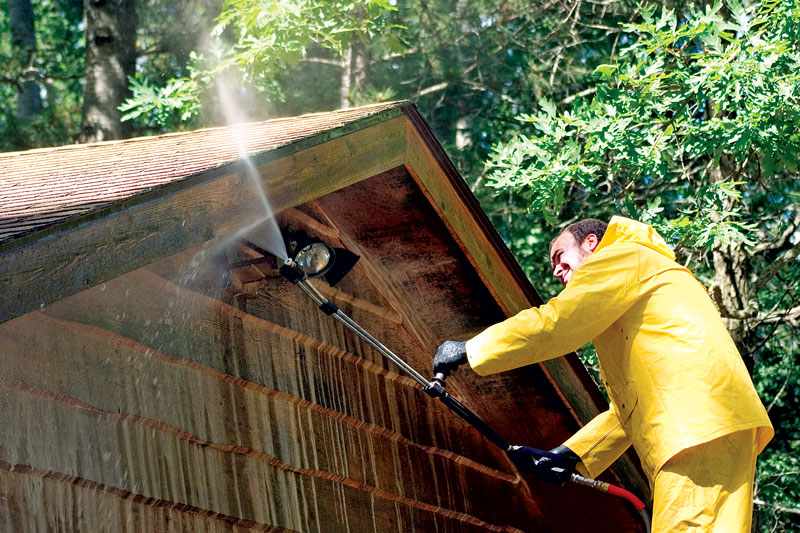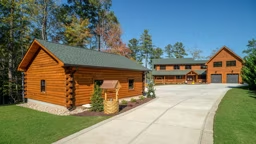You can keep your log home's wood in like-new condition without needing expensive log replacements.
The thought of maintaining a log home may seem intimidating to some homeowners. But unless you are a self-proclaimed procrastinator, following these easy tips can put your mind at ease. Along with today’s new preservatives and regular spot checks, a log home can be maintained in just a couple of weekends a year. John Wilmes of RBJ Wood Restorations in Missouri offers a variety of log home repair services from
basic stain maintenance to full log replacement. He has observed what happens when a stain system fails and the elements do damage to a wood home.

“A basic re-staining and sealing job costs as little as $1.89 a square foot versus spending $100 per log for a total replacement,” John explains. “The more tools a repairman has to pull out, the more expensive the repair,” Services can range from as little as $2,000 up to $11,000 and up for major damage. (*This rate varies throughout the country.) With his hands-on knowledge, John offers some advice that could help homeowners keep trouble at bay. If a home is properly maintained, a full re-staining can be done every seven to eight years. Maintenance during these in between years can be as little as just washing off logs and maybe re-applying a topcoat, or in some cases, even re-staining and sealing a small area where the elements have gotten a foothold on your logs.
John has found that certain areas of the home seem to have more trouble than others. Problem areas are:
- The deck or balcony of a home can be a tricky area. If the area is not covered by a roof or awning the rain back-splashes from the deck to the exterior log wall and creates a battered area that homeowners should keep an eye on. If the log starts to change color, then it might be time for a spot wash, dry and re-stain of that area.
- Southern and western walls receive more sun, which can do just as much damage as moisture to the walls, and they need to be protected from damaging UV rays. The heat and radiation from the sun breaks down the fibers of the log, which not only degrades the wood, but also offers a place for water and insects to enter.
- Breezeways are a great catchall for dirt and debris along with being a home for insects and birds. Dirt, flyspecks, spider webs and bird droppings all create a holding place for moisture and can have an accumulative effect over time.
- The extended corners of the logs are more exposed than the rest of the wall. They have less protection from the sun and rain while catching the wind and flying dirt. These areas need to be given extra protection including treating the log ends with special sealing products.
- If your home has dormers or multiple rooflines, be on the lookout. Wherever roof meets wood is where trouble can start. See the picture at right for an example of a home design with dormers and/or roof lines that meet each other. These elevated places can easily begin to rot if they don't get regular close inspections.
Concerned about ceiling maintenance? Learn more about plaster ceiling repair.
 “A basic re-staining and sealing job costs as little as $1.89 a square foot versus spending $100 per log for a total replacement,” John explains. “The more tools a repairman has to pull out, the more expensive the repair,” Services can range from as little as $2,000 up to $11,000 and up for major damage. (*This rate varies throughout the country.) With his hands-on knowledge, John offers some advice that could help homeowners keep trouble at bay. If a home is properly maintained, a full re-staining can be done every seven to eight years. Maintenance during these in between years can be as little as just washing off logs and maybe re-applying a topcoat, or in some cases, even re-staining and sealing a small area where the elements have gotten a foothold on your logs.
“A basic re-staining and sealing job costs as little as $1.89 a square foot versus spending $100 per log for a total replacement,” John explains. “The more tools a repairman has to pull out, the more expensive the repair,” Services can range from as little as $2,000 up to $11,000 and up for major damage. (*This rate varies throughout the country.) With his hands-on knowledge, John offers some advice that could help homeowners keep trouble at bay. If a home is properly maintained, a full re-staining can be done every seven to eight years. Maintenance during these in between years can be as little as just washing off logs and maybe re-applying a topcoat, or in some cases, even re-staining and sealing a small area where the elements have gotten a foothold on your logs.











